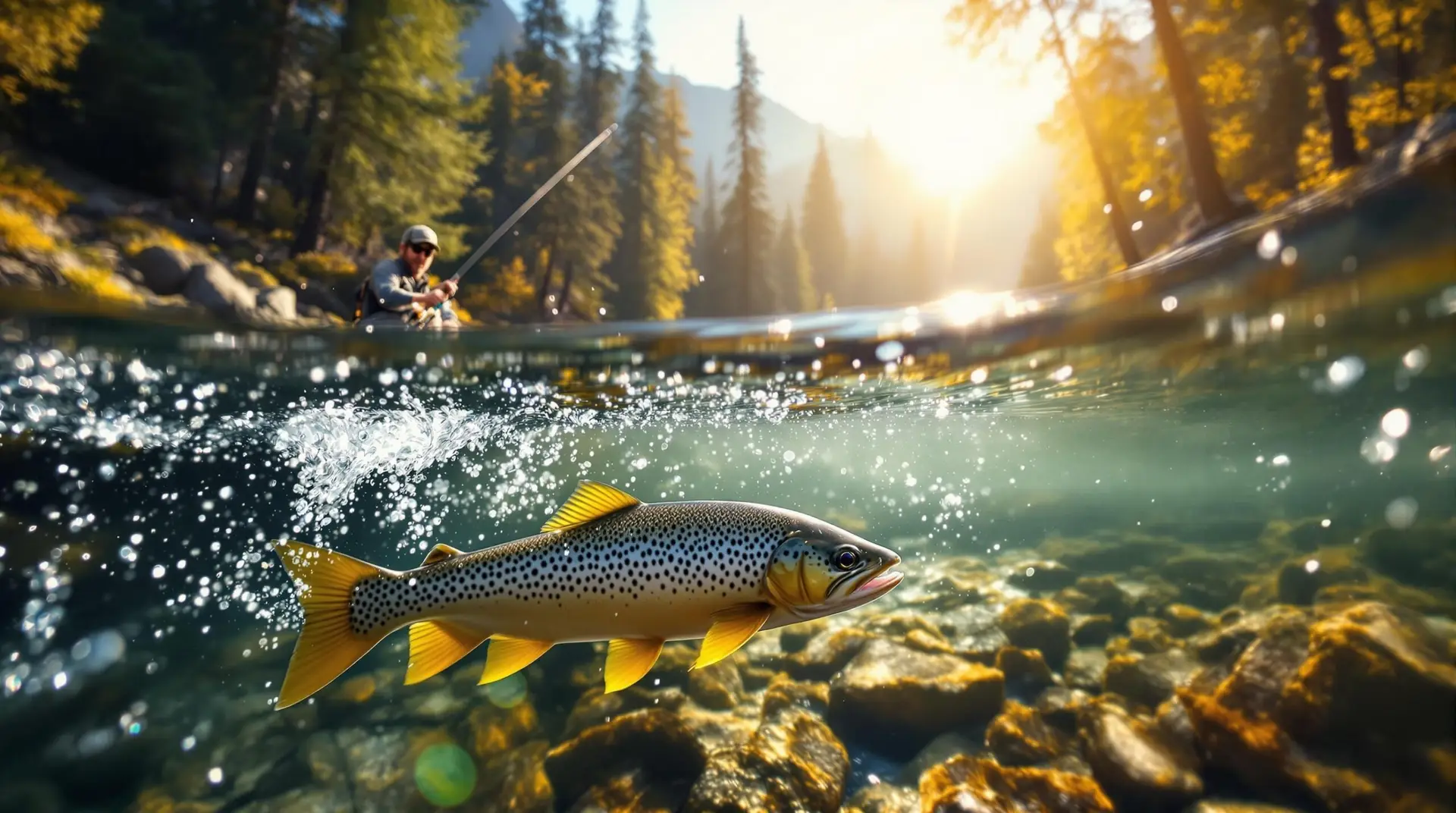Nymphing Technique Strategies
Advanced fly fishers know that mastering nymphing is both an art and a science. Let’s break down some easy-to-grasp methods for fine-tuning your nymphing game.
Nymph Patterns and Effective Sizes
Choosing the right nymph pattern is important, but how you present it often takes center stage. According to some insights, fish in early spring are more likely to fall for a well-placed nymph on a dead drift, regardless of the pattern itself. Larger nymphs tend to stand out and can provoke a bite even more than smaller ones.
| When | Nymph Size That Works |
|---|---|
| Early Spring | Go Big |
| Late Spring | Mix it Up |
| Summer | Small and Sneaky |
Check out our nymph pattern selection page for more tips on picking the right patterns for the right time.
Indicator Fishing for Nymph Drift
Strike indicator nymphing is a popular technique for keeping a steady eye on your nymph’s drift. Using two differently colored indicators can help you see what’s going on, even if the light is tricky. Smart use of indicators can help you nail the perfect dead drift, which keeps your nymph dancing just right in front of those fishy customers.
| What You Do | What You Get |
|---|---|
| Double Indicators | Easier to See |
| Align Right | Keep It Drifting Right |
| Track Distance | Know Exactly Where it is |
For a deeper dive into indicator use, visit our guide on nymph indicator techniques.
Adjustments for Proper Nymph Drift
Nailing your nymph drift means playing around with your setup as water conditions change. Consider these tweaks:
- Get the Depth Right: Make sure your nymphs are chilling where the fish are hanging out.
- Weight Matters: Properly placed weight is key to getting those nymphs down where they belong. Learn more on our page dedicated to nymph rig weight placement.
- Fix Your Drift: Try the contact nymphing technique to feel subtle bites and keep your drift on point.
| What You Change | What It Does |
|---|---|
| Depth | Matches Fish Zones |
| Weight | Gets It Sinking Just Right |
| Drift | On-the-Fly Adjustments |
For more on mastering your drift, swing by our technical nymph fishing resource.
Tweak away, keep those nymphs breezy, and you’ll be nymphing like a pro. Play around with these pointers and remember—the small stuff can separate the catch from the fish tale. Happy fishing!
Understanding Aquatic Diptera
True flies, known in the fancy talk as Aquatic Diptera, are the unsung heroes of water life. They juggle all sorts of roles in their watery homes, making them way more important than your average housefly.
Role in Ecosystems
These little critters—and especially their baby versions—get their party tricks from their knack for orders like burrowing, grazing, feasting on the floaty stuff, and good ol’ hunting. What they bring to the table isn’t just a neat show—it’s a mix of stirring things up, passing out nutrient snacks, and shaping the party for every pond and stream in town. Here’s a taste of what they’re up to:
- Nutrient Deliveries: They munch on dead stuff, breaking it down so other water buddies can feast on the nutrients.
- Home Makeovers: By digging and munching, they switch things up for their plant and animal neighbors.
- Food Web Glue: With them around, the web of who-eats-who gets all tangled up, supporting more critters in the water.
Importance as Food Resources
For many fish, bugs, and birds, these fly kiddos are dinner. Lots of fish see them like we see a hearty meal (NCBI). Chironomid larvae—a fan fave among fish—are like nature’s buffet in streams, perfect for those who geek out over nymph drift mechanics.
| Creature | Percentage Chillin’ on Diptera Larvae |
|---|---|
| Fish | 70% |
| Frogs and Friends | 50% |
| Water Birds | 45% |
| Other Bugs | 60% |
This cheat sheet highlights just how much of a friendly neighborhood they are to so many different species, showing why they’re kind of a big deal in the watery world.
Environmental Significance
These larvae don’t just laze about—they’re like the water’s health report card, able to spill the beans on how ‘clean’ a stream is (NCBI). Maybe their absence means dirty water, so scientists love using them for checkups on nature’s plumbing.
Here’s what they tell us:
- Water Quality Snitches: They’re quick to wave the red flag when water’s in trouble.
- Saving Water Homes: Knowing their role helps folks keep ponds and streams in tip-top shape.
- Science Pro Tips: Studying them helps unravel how our actions may ripple through watery worlds.
For those mastering the fishing art, this Diptera knowledge can hook you into better fly choices for those stealthy nymph pattern picks.
If you’re itching for more insider info, check out lessons on contact nymphing technique, multiple nymph rigs, and the smarts of technical nymph fishing. Every link opens up chapters to better understand these fly maestros and to refine your fishing finesse, wetting lines and upping your underwater game.
Advancements in Nymphing Methods
Nymphing has come a long way over the years. Fly fishing folks are now reeling in advancements in tightline nymphing, the perks of longer rods, and newfangled nymph toys that make fishing a whole lot more fun.
Evolution of Tightline Nymphing
Fly fishers, listen up! Tightline nymphing techniques might sound like something out of a secret spy manual, but they’ve changed the game since the ’80s and ’90s. Polish, Czech, and French nymphing are three rockstar methods that ditched the floaty indicators, letting anglers feel everything, even the sneakiest bite. It’s like gaining a sixth sense, but for fish bites (TFO Rods).
| Technique | Origin | Description |
|---|---|---|
| Polish Nymphing | Poland | Short casts, heavy flies, aim low. |
| Czech Nymphing | Czech Republic | Mid-length rods, short drifts, and weighted flies. |
| French Nymphing | France | Long lines, light flies, and distance roles. |
Want the full scoop on these methods? Check out our juicy french nymphing guide and contact nymphing technique articles.
Benefits of Lengthy Nymphing Rods
Long rods aren’t just for knights in medieval tales—they’re a fly fisher’s best friend. These elongated beauties, spanning 9 to 12 feet, can be a real catch. They help anglers reach further without spooking the fish, especially in waters so clear you could practically see your reflection.
| Rod Length | Flexibility | Suitability |
|---|---|---|
| 9′ to 10′ | Handy | Good for average rivers |
| 10′ to 12′ | Extra Reach | Perfect for big rivers and high nymph action |
Take the Temple Fork Outfitters (TFO) Drift rod for a spin—it can change length to suit your needs. Curious? Get your rod geek on over at best euro nymphing rods.
Innovative Nymph Fishing Products
Welcome to the new age of fishing! Nymph fishing has been tricked out with top-notch gear: thin fly lines that barely drag, weight-forward lines that listen to your every cast, invisible leaders, and anchor flies hefty enough to stay put in rapids (TFO Rods).
| Product | Description | Benefit |
|---|---|---|
| Thin Fly Lines | Drag-shrugging design | Magical drift control |
| Weight-Forward Lines | Weighted for better throws | Cleaner casting action |
| Long Leaders | Fluorocarbon, thin as a whisper | Ninja-like invisibility in water |
| Anchor Flies | Extra weight | Grab onto the bottom like sticky buns on a plate |
If you’re hunting for the right gear, peek at euro nymphing tools and best comp nymphing lines.
In a nutshell, these groundbreaking changes in nymph fishing gear and techniques, like tightline magic and longer rods, have made fishing smarter and sassier. If you’re itching to know more, we’ve got the goods over in our advanced euro nymphing section. Dive in!
Tackling Trickier Waters
When the water’s running high, it brings along its own quirks for those who love casting a line. These circumstances test even the seasoned anglers, but also open up a treasure chest of sweet fishing ops. Getting the hang of high water fishing is crucial if you’re itching to become a pro at the nymph drift game.
Trout Spawning Season Tactics
Rising rivers mean trout are on the lookout for peaceful pockets away from the fast and furious flow. They duck into calmer spots like backwaters, eddies, and under anything that can block that tiring rush of water. Nail the fly presentation near these zones at the river’s floor to snag those sneaky swimmers (Fly Fisherman).
Here’s what could work:
- Dry-dropper combos: Pairing a dry fly with a sneaky nymph keeps the nymph hidden where it should be while you can still keep an eye on things.
- Supersized dry flies: Bigger flies make a splash and catch eyes in all that chaos.
- Anchor rig/Czech nymphing: Heavy flies keep your line tight and make sure you feel every little tick along the way.
Picking the Right Flies
Picking flies that pop in high waters is a game-changer. Here’s a cheat sheet:
- Bold colors: When the water’s murky, go for a pink, chartreuse, or black fly to stand out (Fly Fisherman).
- Hefty and light flies: Mixing it up with both weighted and lightweight flies helps reach those hiding at the bottom.
- Lifelike swimmers: Leeches and crayfish patterns move like the real deal, up your chances with styles like the wet fly swing.
| Fly Type | Best Colors | Suggested Patterns |
|---|---|---|
| Dry Droppers | Natural ‘n Bright | Adams Parachute, Chubby Chernobyl |
| Weighted Nymphs | Pink, Chartreuse, Black | Pat’s Rubber Leg, Hare’s Ear Nymph |
| Swimming Flies | Dark, Natural | Black Woolly Bugger, Olive Zonker |
Ways to Combat Underwater Currents
Fighting underwater currents needs smart moves to keep nymphs doing their thing. Here’s the scoop:
- Depth setup: Placing the indicator 1.5 times below the water keeps the nymph skating right above snag central (Missoulian Angler).
- Czech nymphing again: Keeps that line stick-straight, so you feel every pebble and avoid the fishy fakery.
- Wet fly swing: Hurl it across the current and let it dance back in to mimic the real critters (Fly Fisherman).
Hop over to our deep water nymphing guide for more insider techniques.
By mixing these tactics, nailing fly choices, and tweaking your style, you’re all set to win at high waters and master nymph drift game. Don’t miss out on more tips in our pieces on technical nymph adventures and current seam tricks.

